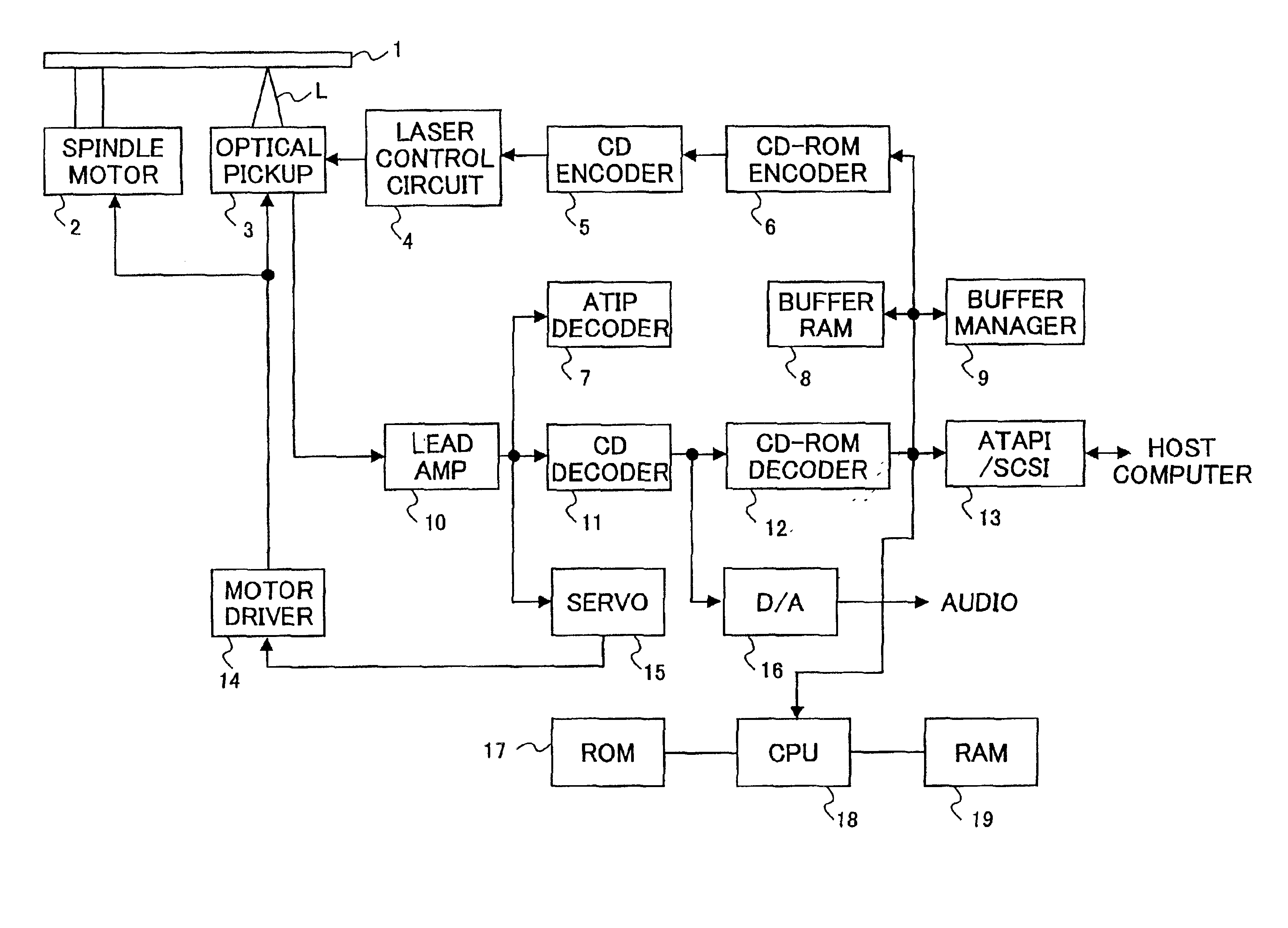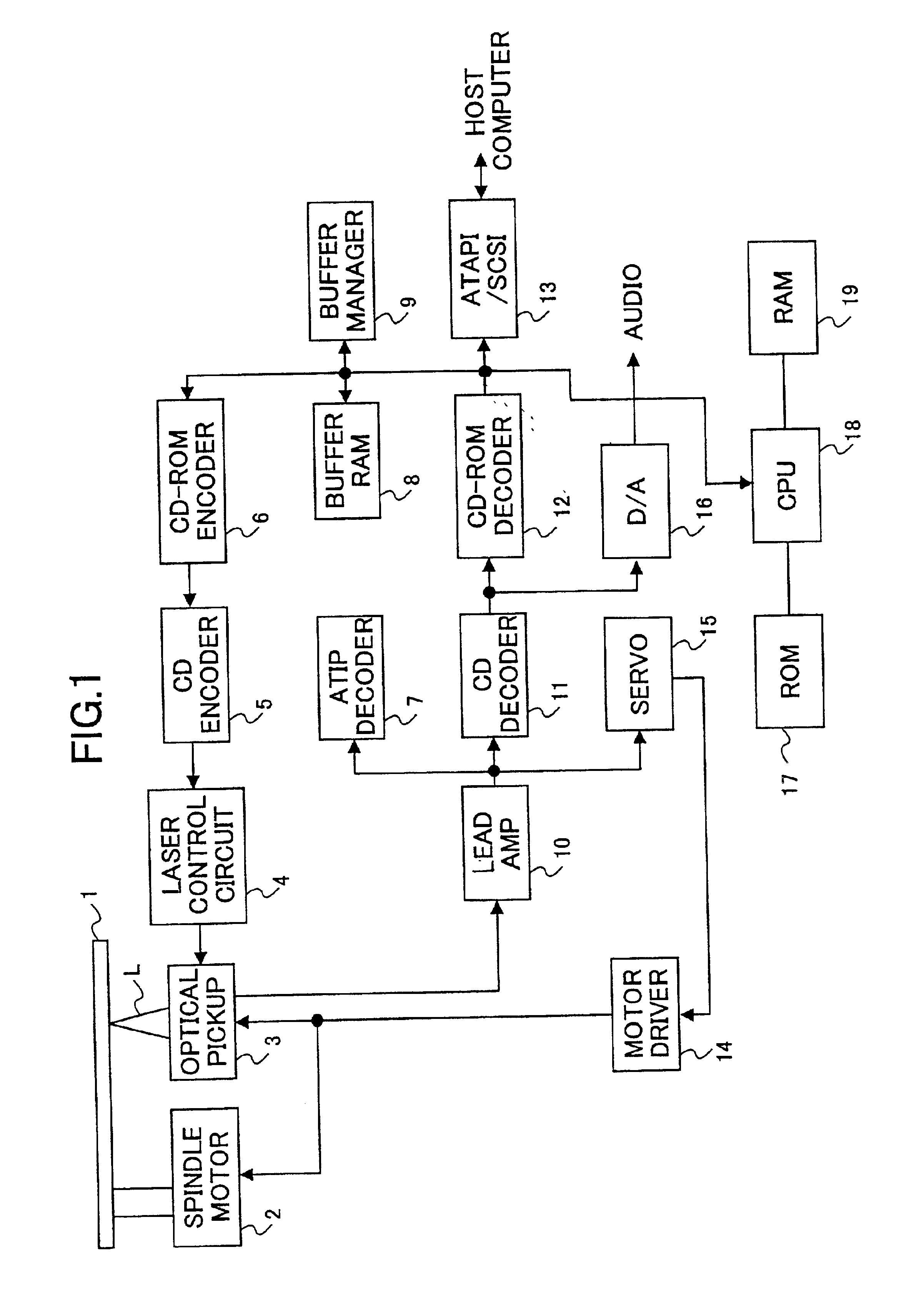However, a servo
signal may be distorted due to various external disturbances, and an off-servo state may occur.
Particularly when a rate at which the information is to be recorded becomes high, it becomes more difficult to carry out a stable servo.
However, because a
signal level of the ATIP signal is extremely small, it may be difficult to detect the ATIP signal due to various external disturbances.
Particularly when a rate with which the information is to be recorded becomes high, it becomes more difficult to detect the ATIP signal.
For example, the recording error is caused by a shock, vibration or the like.
When a temperature of such an optical disk unit, particularly a temperature of an optical
system portion called an
optical pickup, rises, a
light emission characteristic of the
laser diode which is used for recording the information may change, and an error may be generated during the recording.
In addition, even if no error is generated during the recording, a recording quality may be deteriorated by the temperature rise.
As a result, there is a possibility of recording an optical disk from which the information cannot be reproduced.
But in the first example of the conventional information storage apparatus, although it is possible to prevent an erroneous recording on the track by suppressing the
light emission of the
laser diode at a
light emission power which would
record information when the servo error is generated, there was a first problem in that the data recorded up to that point in time cannot be utilized.
Particularly in the case of a write-once
optical recording medium, such as a CD-R, which can only be recorded with information once, a storage capacity of the
optical recording medium may be wasted, and a time used to make the recording up to that point in time may be wasted.
On the other hand, in the above described information storage apparatus, the servo errors include a servo error detected by the
tracking error signal.
For this reason, if all of the servos are once turned OFF and then turned ON to obtain the on-servo states, there was a second problem in that it may take too much time for the servos to stabilize.
As a result, there was a third problem in that there is a possibility of deteriorating the recording quality of the
optical recording medium which is recorded with the information.
In this case, even if the information recording is interrupted upon detection of the servo error and the recording is resumed so that there is no discontinuity with the data recorded immediately before the recording was interrupted, the servo error is generated again, and a loop for interrupting and resuming the information recording is repeated, and there was a fourth problem in that the information recording may not end.
Moreover, in the above described information storage apparatus, when the information recording is interrupted upon detection of the servo error and the recording is to be resumed so that there is no discontinuity with the data recorded immediately before the recording was interrupted, there was a fifth problem in that the time finally required to
record the information may become extremely long if the recording rate is changed at the first detection of the servo error, in a case where the cause of the servo error detection is other than the rotational speed of the optical recording medium.
In some cases, there was a sixth problem in that the recording is performed out of
synchronism with respect to the rotational speed of the optical recording medium and a write error may be generated if the situation becomes worse.
Particularly in the case of the write-once optical recording medium, such as the CD-R, which can only be recorded with information once, the recording capacity of the optical recording medium may wasted if the write error occurs, and the time used to make the recording up to that point in time may also be wasted.
In such cases, the ATIP error rate immediately after the recording is resumed is high, and the interruption and resuming of the information recording are repeated.
As a result, there was a seventh problem in that the information recording may not end.
In such cases, the ATIP error rate is large for the same recording rate, even if the information recording is interrupted and resumed as the ATIP error rate increases.
Consequently, there was an eighth problem in that the interruption and resuming of the information recording are repeated, and the information recording may not end.
On the other hand, in the above described information storage apparatus, when the information recording is interrupted upon detection of the increase of the ATIP error rate and the recording is to be resumed so that there is no discontinuity with the data recorded immediately before the recording was interrupted, there was a ninth problem in that the time finally required to
record the information may become extremely long if the recording rate is changed at the first detection of the increase of the ATIP error rate, in a case where the cause of the increased ATIP error rate is other than the rotational speed of the optical recording medium.
In the third example of the conventional information storage apparatus, in the case of the write-once optical recording medium, such as the CD-R, which can only be recorded with information once, there was a tenth problem in that the recording capacity of the optical recording medium may wasted and the time used to make the recording up to that point in time may also be wasted, if the recording is interrupted due to the shock, vibration or the like.
However, if the shock, vibration or the like is due to internal causes such as a cause due to the rotational speed of the optical recording medium, the shock, vibration or the like is generated under the same conditions even when the information recording is resumed, and the interruption and resuming of the information recording may be repeated.
Consequently, there was an eleventh problem in that the final recording rate may become low, and the information recording may not be resumed and completed.
Moreover, in the above described information storage apparatus, when the information recording is interrupted upon detection of the shock, vibration or the like and the recording is to be resumed so that there is no discontinuity with the data recorded immediately before the recording was interrupted, there was a twelfth problem in that the time finally required to record the information may become long if the recording rate is changed at the first detection of the shock, vibration or the like, in a case where the shock, vibration or the like is temporary because such temporary shock, vibration or the like will not be generated again.
In addition, in the above described information storage apparatus, there was a thirteenth problem in that a shock sensor is required in general to detect the shock, vibration or the like, and a redundant circuit associated therewith needs to be added.
Hence, the converging state cannot be controlled with respect to a temperature change in a range in which the change exceeds the predetermined level, and there was a fourteenth problem in that the recording quality deteriorates and the recording error occurs.
Particularly in the case of a write-once optical recording medium, such as the CD-R, which can only be recorded with information once, the storage capacity of the optical recording medium may be wasted, and the time used to make the recording up to that point in time may be wasted.
For this reason, the detected temperature easily becomes greater than a predetermined high temperature, and there was a fifteenth problem in that there are possibilities that pause and rewrite of the information recording will occur frequently, and that the write will not be completed in a worst case under the high-temperature condition.
On the other hand, if the initial temperature is extremely low, there is a possibility that the recording quality will deteriorate before the predetermined high temperature is reached.
In addition, in the above described information storage apparatus, the detection of the high temperature may be caused mainly by the light emission of the
laser diode which is used for the information recording and urges a temperature rise of the
optical pickup.
Furthermore, as the recording rate becomes high, the light
emission power of the
laser diode required for the information recording becomes high, and the temperature easily rises.
In other words, when the information recording is interrupted upon detection of the
internal temperature rise due to the high light
emission power of the
laser diode required because of the high recording rate and the recording is to be resumed so that there is no discontinuity with the data recorded immediately before the recording was interrupted, there was a sixteenth problem in that the interruption and resuming of the information recording are repeated, and the information recording may not end.
Furthermore, in the above described information storage apparatus, if the cause of the detected high temperature is other than the rotational speed of the optical recording medium, the cause is not eliminated by reducing the rotational speed upon the first detection of the high temperature.
Consequently, the high temperature is reached again, which results in the interruption of the recording and resuming of the recording at a reduced rotational speed, and there was a seventeenth problem in that the recording rate of the information recording may becomes extremely low.
 Login to View More
Login to View More 


